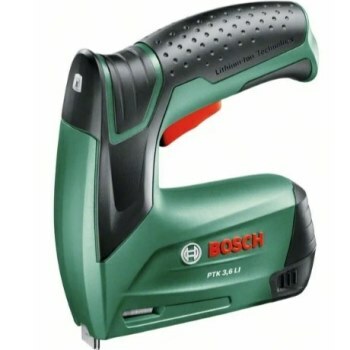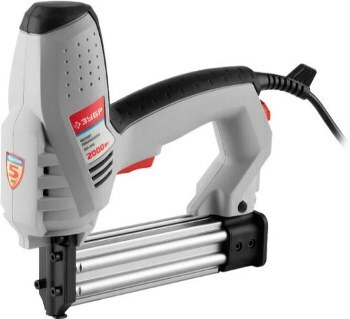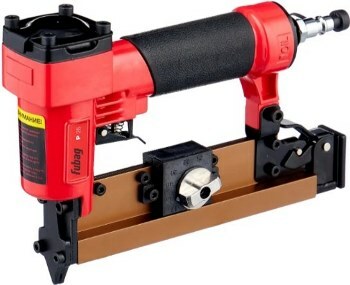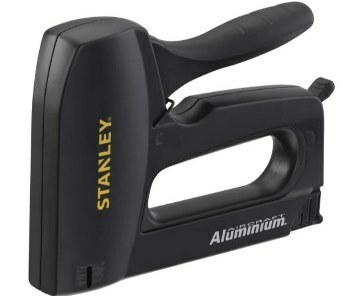The construction stapler is similar to the most common one used in offices for stapling paper, but more powerful, because it is needed for a variety of materials, including durable and stubborn materials. The construction stapler serves as a replacement for a hammer, greatly simplifying the work, because instead of a dozen blows, you only need to make one press. In this article, we will show you how to choose this useful machine and present to your attention our independent rating of the 5 best construction staplers.
CONTENT
- 1 Why do you need a construction stapler
- 2 Types of construction staplers
- 3 What to look for when choosing a construction stapler
- 4 Top 5 construction staplers
- 5 FAQ
Why do you need a construction stapler
A construction stapler in skilled hands is capable of a lot. Depending on what materials you intend to work with more often, and it is worth choosing it - one is best suited for upholstery and furniture upholstery, the other for installing insulation, and so on. If previously only staples were used in staplers, now they "learned" to hammer nails and pins, which is why they have become even more popular. They have a lot of advantages:
- when using it does not require much effort to nail down materials;
- installation is faster than with a hammer;
- the tool usually does not need to be pressed hard, so you can work in an unstable position;
- the stapler is indispensable for delicate work - the material is minimally damaged (for example, this is very important for glass);
- very versatile;
- it is much safer to use than a hammer.
Types of construction staplers
If you decide to purchase this tool, you will surely find that there are a lot of options. To choose the most suitable one, you need to understand a little about the types and characteristics. Let's start with types - there are three main ones.
Mechanical
Their design is simpler than that of the other two types and, what is important, there are practically no parts subject to rapid wear in it - springs are usually the first to fail. It is not difficult to maintain them: it is enough just to lubricate sometimes. They do not depend on anything, they are lighter and more compact than others. These are significant advantages, but they are associated with the fact that mechanical staplers are powered mainly by muscle power, and here the main disadvantage is hidden: when working with them, you need to make tangible efforts, and therefore they are not intended for large volumes works. In addition, they are used only for simpler materials, for complex materials, more powerful pneumatic models will be required.
Mechanical staplers are divided into those equipped with coil and leaf springs. The former require a lot of effort and have a serious return, the latter are easier to work with, but more expensive. In general, the issue of recoil is generally very important for mechanical staplers: special pads on the handles are designed to absorb it, and the cases are designed so as to distribute it over the entire palm. The lower the recoil and noise, the better the model.
To summarize: mechanical staplers are simple and inexpensive, suitable for those who plan to use them for small-volume jobs. If you have to use a stapler a lot and often, it is better to dwell on a model of a different type, since you will not be able to work quickly with a mechanical one, and the hand will get tired.
Electrical
It is much easier to work with them than with mechanical ones. You just need to press the button for the mechanism to start - no need to put in efforts, because all the work is done by an electric motor, so that even a child can cope with a large tool power. In addition, the work will go much faster, and it will be possible to punch harder materials. Finally, and they will be connected much stronger than using a mechanical stapler.
To avoid the danger of electric shock, the casings are made of plastic, and the handles are rubberized. The power of electric staplers can be up to 1000-1500 watts. They often have staples up to 25 mm long (sometimes up to 50 mm), while mechanical staples rarely exceed 15 mm. In a word, the parameters of electric models are more impressive.
Their main disadvantage is that they require mains power, which limits their use. It is not always possible to reach even with an extension cord, and sometimes during construction, electricity has not yet been supplied at all. But this only applies to network staplers, in addition to them there are also rechargeable ones. True, with the same characteristics, they will cost more, moreover, they are heavier, so when working with them the hand will get tired faster. Electric batteries are generally heavier than mechanical ones - this is another drawback.
An important characteristic when choosing is the number of pulses per minute, since they are often not enough. In this respect, pneumatic staplers are superior to electric ones. However, for domestic needs, 20 rounds per minute are usually enough.
Pneumatic
They work due to the force of air under pressure. The process itself takes place almost instantly, you don't have to make any efforts for this. Pneumatic staplers also weigh less than electric staplers, but there is an important detail here: they require a compressor, and it is large and heavy. Because of this, pneumatic models are less suitable for carrying, and they are usually bought if there is no need for it. They are most popular with professionals due to their high productivity and the ability to handle long staples and fairly large nails.
In terms of power, they surpass the previous types, while their design is quite simple, due to which servicing them is also easy, it is enough just to clean them sometimes, moreover, they can work for many years without breakdowns. Only the O-rings are subject to wear, but they are easy to replace and cheap.
An important characteristic when choosing is air consumption. If it is moderate, a 20-30 liter compressor is sufficient. Even so, the compressor still complicates the use significantly, making the pneumatic stapler a priority choice for production and a full-fledged construction site. For routine repairs, and even more so for solving frequently occurring household tasks, other types of tools are better suited.
What to look for when choosing a construction stapler
In addition to the type, there are also significant characteristics when choosing. Let's consider them in more detail:
- Sizes of staples - usually those that fit the stapler are indicated in the instructions for it, on the packaging or directly on its body. Staples differ not only in size, but also in shape and type of sharpening of the ends. The easiest way to navigate is by type.
- Pen - it is worth trying before buying how comfortable it is to hold the stapler. The handle should fit well in the hand, otherwise it will be inconvenient to work. If it is large enough and the stapler needs to be transported, it is advisable that it be foldable. It is also useful for transportation to have the ability to block the trigger - if it is not there, and the handle is not folding, the staples from the tool will need to be removed each time.
- The ability to adjust the force of impact - for materials of different strength and hardness, the impact force should be different, and on staplers there are usually special switches with which you can change it.
- Viewing window - lets you know how many staples are left in the tool. With him, the fact that their supply has run out will not come as an unpleasant surprise.
To choose the most suitable stapler, it is worth deciding on:
- how often you will use it;
- where and in what conditions you will do it;
- what materials are you mainly to deal with?
Based on this, it will be easy to determine the preferred parameters - whether you need a powerful tool, whether it should be autonomous, whether it can have large dimensions and weight, or should it be as small and lightweight as possible - and so Further.
You can carry out a simple check before buying: take birch plywood with you to the store (this is a rather difficult material for staplers), moreover, as thick and dry as possible, and ask the seller, or try to hammer a few staples. In this case, you need to take the longest staples from among the suitable ones. If all goes well, then the stapler will fit perfectly. In fact, very few pass such a test, therefore, if you need a simpler and cheaper tool, you can take a simpler material - the one with which you plan to work most often.
Top 5 construction staplers
We have selected five different types of tools, each of which copes well with its tasks.
Best cordless stapler
1. BOSCH PTK 3.6 LI 0.603.968.120

It combines versatility, reliability and reasonable cost - it cannot be called cheap, but it will not be a ruinous purchase (4,100 rubles). It can be used both for sheet materials and as furniture. The speed is 30 rounds per minute, which is quite enough for domestic needs. You can use staples and nails with it (but suitable ones are not easy to find on the market).
It is easy and convenient to work with the tool, it weighs a little. The battery charge lasts for a thousand shots. But after discharging, you will not be able to quickly change the battery, you will have to charge the device. The shot is fired only if, when the button is pressed, the spout fits snugly against the surface.
Price: ₽ 4 089
BOSCH PTK 3.6 LI 0.603.968.120
Best Electric Stapler
2. ZUBR ZSP-2000

With it, you can use long staples and nails (up to 25 and 30 mm, respectively), which is a rarity for electric models. The power can be adjusted, which makes the model multifunctional, however, it cannot be used as a furniture one - even the minimum will be too high for this.
ZSP-2000 is best suited for plywood, insulation and other thick materials. It weighs quite a lot (about 1.5 kg) and consumes 2,000 watts, provides 20 beats per minute. It is not very accurate, and nails can get stuck from time to time, but otherwise it is a reliable and durable tool at a reasonable price of 3,700 rubles.
Price: ₽ 3 690
ZUBR ZSP-2000
Best pneumatic stapler
3. Fubag P25

The tool is perfect for finishing work, for example, fixing platbands and various decorative elements. Studs from 10 to 25 mm in length can be used. The mount is unobtrusive and very reliable. The device weighs 1 kilogram, which is quite a bit for a powerful pneumatic stapler, there is a case in the kit, while the cost is only 2,200 rubles. The stapler is very accurate and reliable - problems with pins are very rare, and even in this case, a jammed pin can be easily and quickly changed. Can be used with studs up to 25 mm, works with any wood.
Price: ₽ 2 170
Fubag P25
Best mechanical staplers
4. Matrix 40911 - Best Hammer Stapler

This model is suitable for furniture upholstery, roofing, wall cladding and others that do not require long brackets and great strength. The dimensions of the staple used can vary within the range of 6-10 mm. Thus, the device is somewhat inferior in functionality to the previous ones, but for ordinary everyday issues more is often not required. At the same time, it is very simple, and therefore reliable, which is facilitated by the materials from which it is made - this is steel and ABS-plastic, which is characterized by high strength. In addition, it is inexpensive - 1,500 rubles.
Price: ₽ 1 489
Matrix 40911
5. STANLEY Light Duty 6-TR150L - Best Mechanical Lever Stapler

The tool works without misfires even when used with cheap staples, it stands out for its simplicity and reliability: the aluminum body is both lightweight and durable. There are two modes of operation: hard and soft hits for materials, harder and easier, respectively. It is worth noting that the tool does not pass the previously described test with birch plywood: the fasteners are not completely included in it, so you have to finish the job with a hammer. However, there are no such problems with simpler materials, and this stapler costs only 1,600 rubles.
Price: ₽ 1 609
STANLEY Light Duty 6-TR150L
FAQ
What can be fixed with a construction stapler?
Most often, this tool is used for chipboard, plywood or wood, but it can also be used to fasten lining, siding, tiles, to mount insulation, and so on.
The stapler knocks out two staples - what to do?
The source of this problem should be found in the striker - most likely it is damaged or cracked.

